Table of contents
- Motorcycles ride well and safely Greetings and content
- Andreas Scheuer, Federal Minister of Transport
- Walter Eichendorf, DVR President
- Matthias Haasper, IFZ
- Michael Pfeiffer, Editor-in-Chief MOTORRAD
- Part 1 – Brakes
- Part 2 – Dynamic wheel load
- Part 3 – Curve Techniques
- Part 4 – Line choice
- Part 5 – Loading the motorcycle
- Part 6 – Driving with a load
- Part 7 – Driving in the wet
- Part 8 – Accident Risks
- Part 9 – Driving in a group
- Part 10 – Reduce the seat height
- Part 11 – tire choice

Valentin Brandes, Stephan Floss Fotorgrafie, SYSTEM, fact
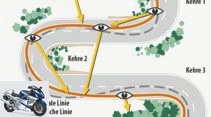
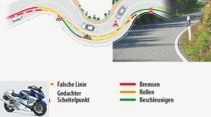
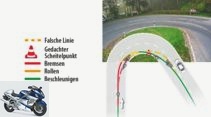
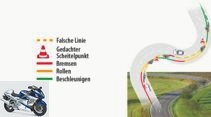
26th pictures
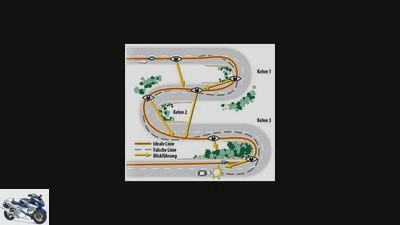
MOTORCYCLE
1/26
On the way on alpine passes? That’s how it works!
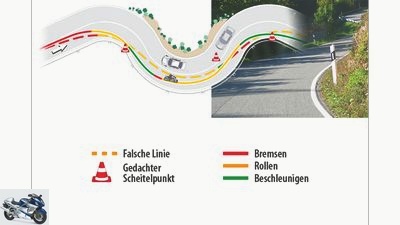
MOTORCYCLE
2/26
Seductive winding curves with risk. The course of the road cannot be seen for the most part, which is why a car or motorcycle can appear unexpectedly – uncomfortable to dangerous when you cut the curves. The so-called undercutting of the curves is therefore better, especially since you always have to expect that a driver in oncoming traffic will cut the S-curve and, in the worst case, come along on the wrong side of the road. If we have then cut the curve ourselves, our chances are extremely slim.
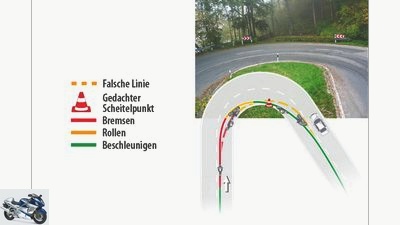
MOTORCYCLE
3/26
The classic curve, which allows a finely arranged ideal line and corresponding leanings due to its clarity. However, if you cut the curve (dashed line), the motorcycle must drive the greatest lean angle at the exit of the curve, if you do not want to go on a collision course with possible oncoming traffic. In the case of undercutting (solid line), on the other hand, the apex is later (pylons). You can see better around the bend, which is why you can accelerate much earlier on the flatter line, which more than makes up for the slightly slower cornering speed.
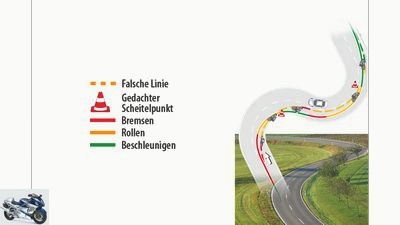
MOTORCYCLE
4/26
In alternating curves, the advantage of undercutting comes into play even more, because the apex, which is set late in the right-hand bend, allows the following left-hand bend to be approached from far outside. The driver on the wrong line (dashed) is pushed in the direction of the opposite lane, and he has to turn hard from an extremely unfavorable position for the following left-hand bend. A liquid, round line cannot be made with it.
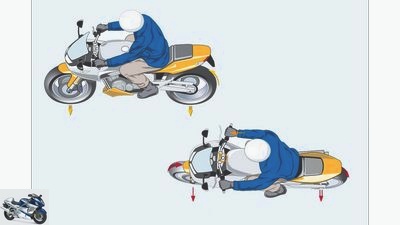
MOTORCYCLE
5/26
The three phases of cornering.
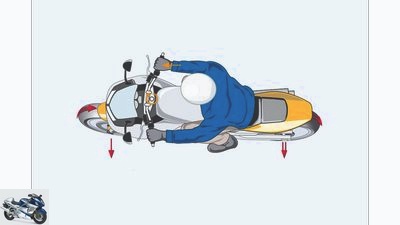
MOTORCYCLE
6/26
Red phase: Adaptive braking before turning. Turning in on the brakes is critical, because many machines, especially those with wide tires, cause an erection torque.
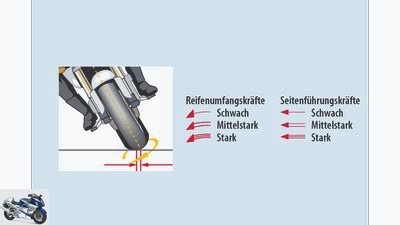
MOTORCYCLE
7/26
The contact area of the front tire moves out of the wheel center plane (see yellow dashed line) and the motorcycle tries to straighten up. The driver has to compensate for this phenomenon by counter-steering. In our driving tests, a necessary counter-steering force of up to 250 Newton meters was found at a twelve degree incline.
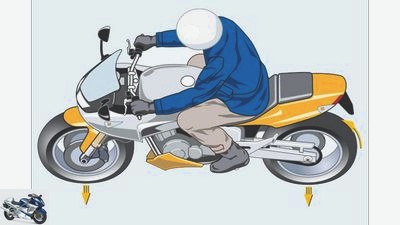
MOTORCYCLE
8/26
Yellow phase: Lean during the roll phase. In this driving state, the circumferential forces on the front wheel are very low, while the driving force acts on the rear wheel depending on the constant speed – at 100 km / h around eight hp. The tires can now transfer high lateral forces and thus cope with an enormous lean angle. If the lean angle is too great, the tires lose their grip, usually the narrower front tire first. Conversely, too low cornering speed can lead to overturning; Early easy acceleration helps.
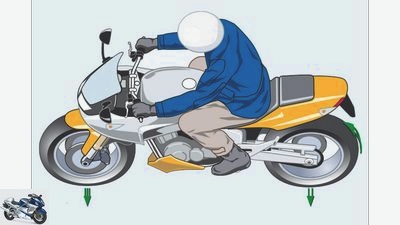
MOTORCYCLE
9/26
Green phase: Accelerate from a lean angle. At the exit of the curve, the gas is gently drawn up, causing the motorcycle to stand up and the curve radius increases. If you want to push the straightening up, additional pressure at the end of the handlebars on the outside of the curve helps. Depending on the acceleration, a more or less strong circumferential force acts on the rear tire. This is why it can withstand less lateral forces and therefore lean angles than the front tire, which guarantees safe lateral guidance in an inclined position.
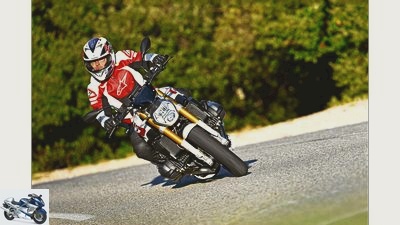
Gargolov
10/26
The classic – lean into the curve: the driver and machine form a line when tilted. Either with a firm knee or a relaxed, sporty knee, this driving style is suitable for all types of curves at any speed. The direction of travel can be corrected very quickly, from laying down you can seamlessly switch to pushing in alternating curves. The relaxed posture does not require much strength. Good to see here: The driver bends his head to keep his horizon as straight as possible, his gaze is directed towards the exit of the curve.
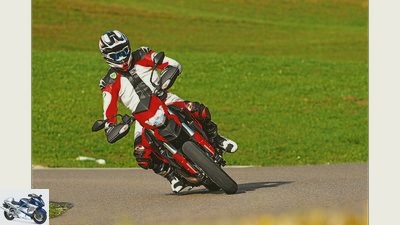
Bilski
11/26
Push: This curve technique originally comes from off-road sports. The driver remains relatively upright, the motorcycle is pushed down with the handlebars. Hip bend and firm knee closure help. This works well in tight bends and serpentines, with quick changes of course or evasive maneuvers. Ideal for gravel roads and on loose or slippery surfaces because the body’s center of gravity is above the tire contact area.
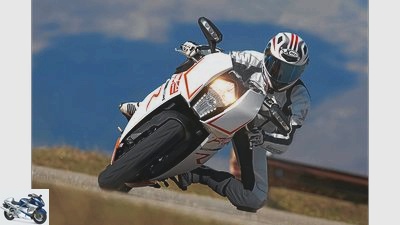
jkuenstle.de
12/26
Hanging-off: This driving style is tailored to the seating position and chassis geometry of super athletes and is mainly used on the racetrack, where the further course of the route is known. With the same cornering speed, it requires less lean angle, but strength and a lot of practice. The photos show that, regardless of the cornering style, a motorcycle needs considerably more space than when driving straight ahead, which is why you should never get too close to the center of the lane when cornering to the left. And to the right, the delineator posts lurk for (athlete) mirrors rushing past too closely.
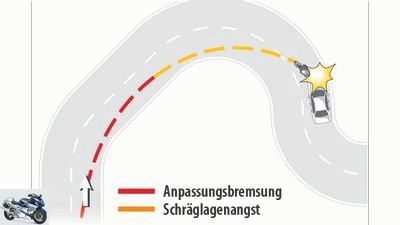
MOTORCYCLE
13/26
You should avoid this mistake.
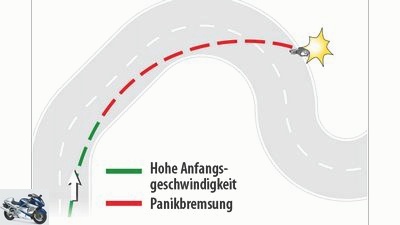
MOTORCYCLE
14/26
This mistake should also be avoided: Too high an initial speed and panic braking.
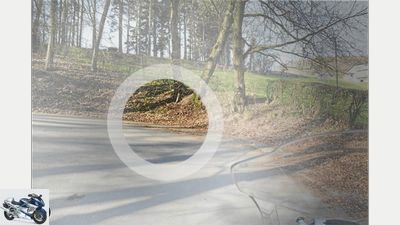
Streblow
15/26
Correct viewing is often difficult uphill. The dirt on the right-hand side of the lane also first demands attention and thus draws attention to itself.
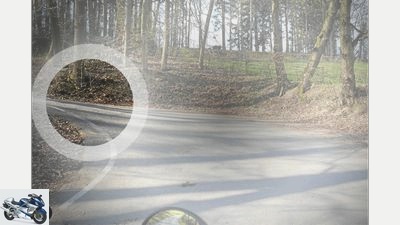
Streblow
16/26
Now it’s time to “keep your head up” and look uphill to see if there is oncoming traffic and how the road will continue. We don’t see yet what the next picture shows.
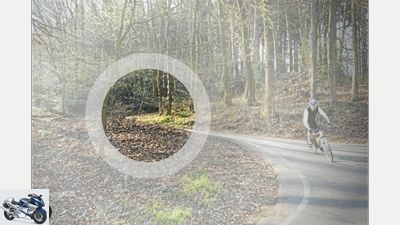
Streblow
17/26
Looking ahead at an early stage prevents us from being frightened by the now emerging cyclist and allows us to perceive the following right-hand bend in good time.
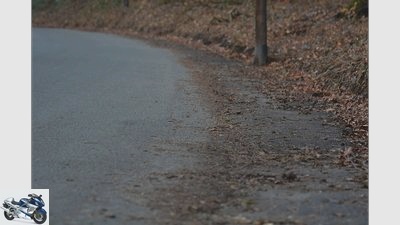
Streblow
18/26
In left-hand bends, the lane can get really narrow. Because if we drove too far to the left we would come into oncoming traffic, and on the right edge of the road there were leaves, gravel and other rubbish. You should stay away from this as much as possible in an inclined position.
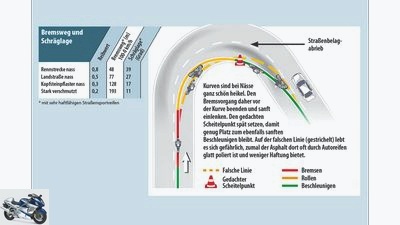
MOTORCYCLE
19/26
The measured values of a Honda CBR 600 F show how different road surfaces in the rain affect the braking distance and the possible lean angle. The braking distance is hardly longer on grippy racetrack asphalt than on dry slopes. On the wet country road, however, the sports touring bike needs 77 meters to brake hard from 100 km / h, and significantly more if the surface is poor. In addition, the possible inclination is drastically reduced.
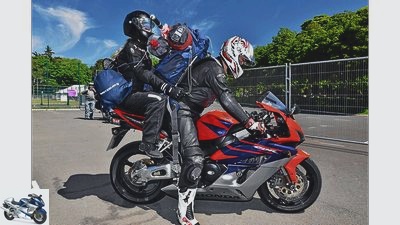
MOTORCYCLE
20/26
Topic loading:
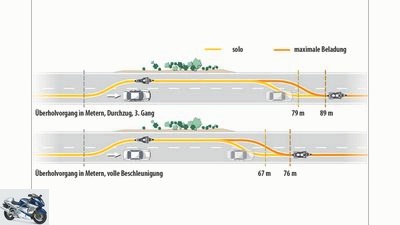
MOTORCYCLE
21/26
A fully loaded motorcycle is slower and less powerful than a machine on which only the driver is sitting. Actually clear, but in the heat of the curve fight on the country road you sometimes forget that, especially when the tour for two and with luggage is more the exception than the rule. The two examples above use a Suzuki GSX 1250 FA to show that overtaking with a load takes significantly longer. The Suzi has at least 98 hp and remains relatively powerful; with weak engines, the path can even double.
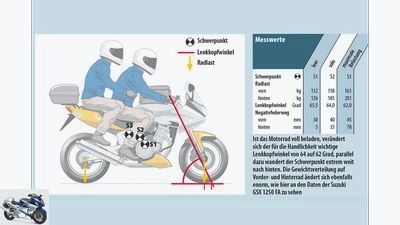
MOTORCYCLE
22/26
Important: The chassis must be adjusted when loading.
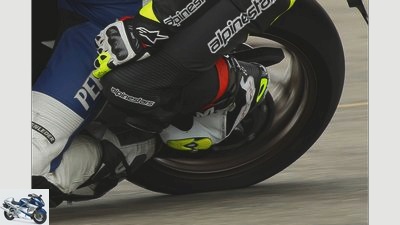
Bilski
23/26
Leaning under a load is hard work for the rear tire. If there is still too little air in it, the rear of the machine can really rock up.
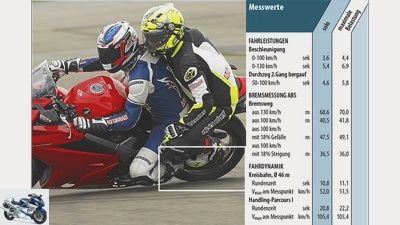
Bilski
24/26
When loaded, the performance and braking behavior of a motorcycle change. Since there is significantly more weight on the rear wheel than normal, the front wheel becomes light when you accelerate and lifts off noticeably earlier. Depending on the tires, handlebar flutter (shimmy) can increase between 60 and 100 km / h. Therefore: Do not drive hands-free or with only one hand on the handlebars when the vehicle is loaded. Anyone traveling in the Alps should take into account that the braking distance increases on steep inclines, as shown by braking measurements with a Honda VFR 800. The other measurement data show that the acceleration and, above all, the pulling power of the almost five hundred pound heavy sports tourer deteriorate significantly – take into account when overtaking!
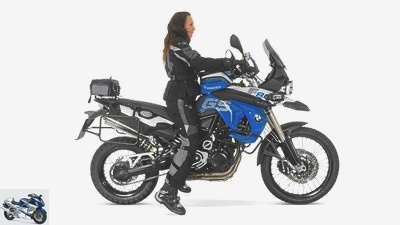
manufacturer
25/26
Sitting position: If, as here, only the tips of your toes reach the floor, it is not enough to just reduce the spring base on the fork and shock absorber. Because not only is the progress too little, such a suspension setting also leads to unsatisfactory driving characteristics.
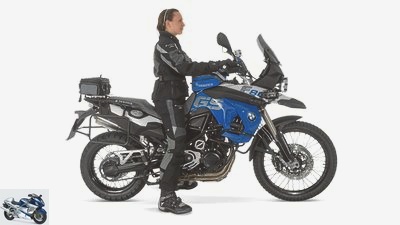
manufacturer
26/26
The lowering kit and the extra-deep seat bring real progress. In the case of the BMW F 800 GS, other fork springs that match the shortened rear shock are installed at the front. All in all, the seat height is reduced by around 70 millimeters.
counselor
Driving experience & Driving tips
Greetings and content
Motorcycles ride well and safely
Greetings and content
Motorcycles ride well and safely
MOTORRAD, together with the BMVI, ifz, DVR and the “Runter vom Gas” campaign, put together a guide to safe motorcycling – with tips, tricks and training opportunities on the subject of “Safe and safe motorcycling”.
Nicolas Streblow
04/02/2019
Andreas Scheuer, Federal Minister of Transport

Valentin Brandes
Andreas Scheuer, Member of the Bundestag, Federal Minister for Transport and Digital Infrastructure.
Spring is the best time for many bikers. The anticipation of endlessly curved mountain passes, the sound of the machine and tours with friends to the most beautiful places knows hardly any limits. Physics, on the other hand, does. Keep this in mind when you go on your first few rides after a thorough technical check of your motorcycle. Hopefully your bike isn’t rusty, but your driving experience probably is. Play it safe and take your time to get back on track. And be patient with other road users. They too have to get used to motorcycles in traffic again. With this in mind: drive considerately and arrive safely.
Walter Eichendorf, DVR President

Stephan Floss Photography
Dr. Walter Eichendorf, President of the German Road Safety Council e. V. (DVR)
Motorcycling is one of the most beautiful forms of mobility, but it is also dangerous. According to the Federal Statistical Office, 580 bikers died in 2017. More than 28,000 were injured, including around 10,000 seriously. Anyone who wants to arrive safely on a motorcycle should act responsibly and always adhere to the speed limits. The theory for a good start to the season can be found here. You will be fit for practice thanks to driver safety training. Together, you will be well prepared for the new season, because you will better assess dangerous situations, react correctly and avoid accidents. Drive with foresight and reach your destination safely at any time.
Matthias Haasper, IFZ

SYSTEM
Matthias Haasper, Institute for Bicycle Safety (ifz)
Enabling riding fun and enjoyment of the motorcycle through increased safety – these are still the goals that the Institute for Two-Wheeler Safety (ifz) has been pursuing since 1981. And this is how it should continue in accordance with the motto “Skill makes you safe”. Because only who knows what he or she is doing is safe on the go. The contents of this brochure have been carefully selected, brought up to date and supplemented with new content in order to keep you enthusiastic and to get to the heart of the safety-relevant factors that determine your journeys on two wheels. The calculation is simple: the fun factor increases if you are well prepared. So, safe driving on all sides and have fun with the exciting content of this guide.
Michael Pfeiffer, Editor-in-Chief MOTORRAD
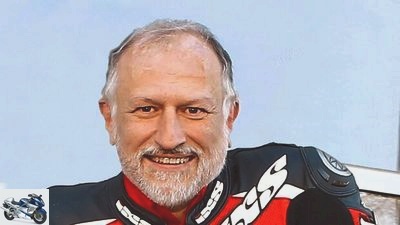
fact
Dipl.-Ing. (FH) Michael Pfeiffer, editor-in-chief of MOTORRAD magazine
We at MOTORRAD have put all our experience on two wheels into this brochure. We have been driving professionally for many years and what the editorial team has experienced over millions of test kilometers flows into this booklet in a highly concentrated manner on the subject of safety. One thing is clear: the current motorcycles now have highly developed electronics and an ABS system is now mandatory. Driving dynamics regulations that intervene in a flash, tires with good grip, the latest lighting technology – the technology now helps a lot. Still, the driver is still crucial. Accelerate, brake, take the right line, the other road users, there is enough to do. Driving consciously remains a duty. So that you always arrive safely.
Part 1 – Brakes
Part 2 – Dynamic wheel load
Part 3 – Curve Techniques
Part 4 – Line choice
Part 5 – Loading the motorcycle
Part 6 – Driving with a load
Part 7 – Driving in the wet
Part 8 – Accident Risks
Part 9 – Driving in a group
Part 10 – Reduce the seat height
Part 11 – tire choice
Related articles
-
Ergonomics and correct sitting
Yvonne Hertler 26th pictures MOTORCYCLE 1/26 On the way on alpine passes? That’s how it works! MOTORCYCLE 2/26 Seductive winding curves with risk. The…
-
The fascination of cornering on a motorcycle
Werel Sports & scene Motorsport The fascination of cornering on a motorcycle The fascination of cornering on a motorcycle And the curve beckons forever…
-
Correct cornering with the motorcycle
Jahn 28 pictures Kawasaki 1/28 Curves are the icing on the cake for motorcyclists. Without them, life on two wheels would be bland. Muller 2/28 3. Green…
-
Driving tips and advice on motorcycling
fact 26th pictures MOTORCYCLE 1/26 On the way on alpine passes? That’s how it works! MOTORCYCLE 2/26 Seductive winding curves with risk. The course of…
-
Cornering Part 1: Technical and psychological basics
fact counselor workshop Cornering Part 1: Technical and psychological basics Cornering Part 1: Technical and psychological basics Drive properly through…
-
MSC cornering ABS in the test in the KTM 1190 Adventure
Jahn motorcycles MSC cornering ABS in the test in the KTM 1190 Adventure MSC in the KTM 1190 Adventure put to the test ABS suitable for lean angles…
-
The right tire choice for a motorcycle
Markus Jahn 26th pictures MOTORCYCLE 1/26 On the way on alpine passes? That’s how it works! MOTORCYCLE 2/26 Seductive winding curves with risk. The…
-
2snap Sports & scene Motorsport Rossi’s cornering technique Rossi’s cornering technique Consultation with the doctor Content of Valentino Rossi chats…
-
Riding with a pillion passenger
archive to travel Riding with a pillion passenger Riding with a pillion passenger Precious cargo True to the motto: “A joy shared is a joy doubled”, many…
-
Photos: Yamaha Sports & scene Electronic security features Against blocking, for traction Electronic safety features on the motorcycle Electronic…